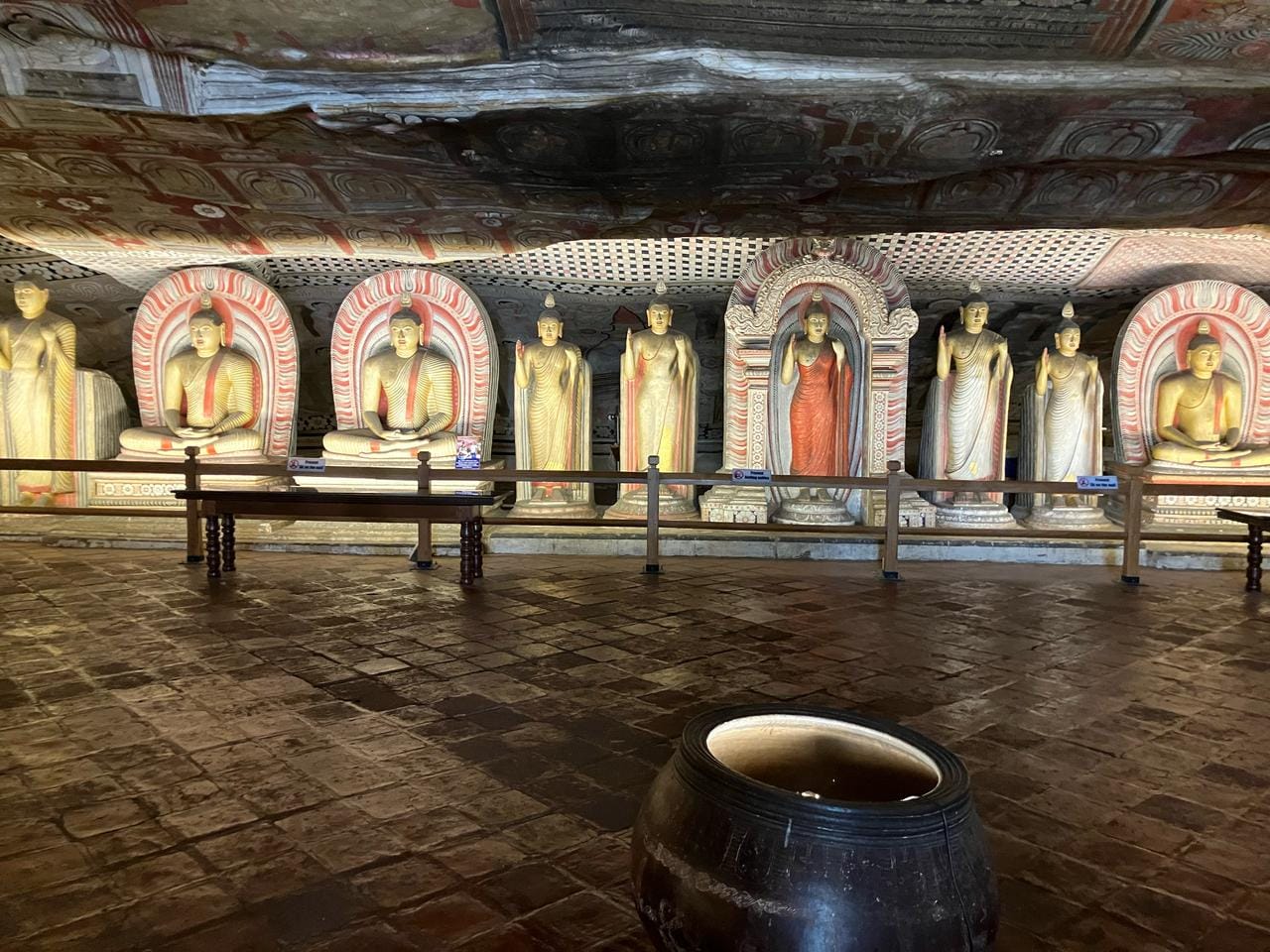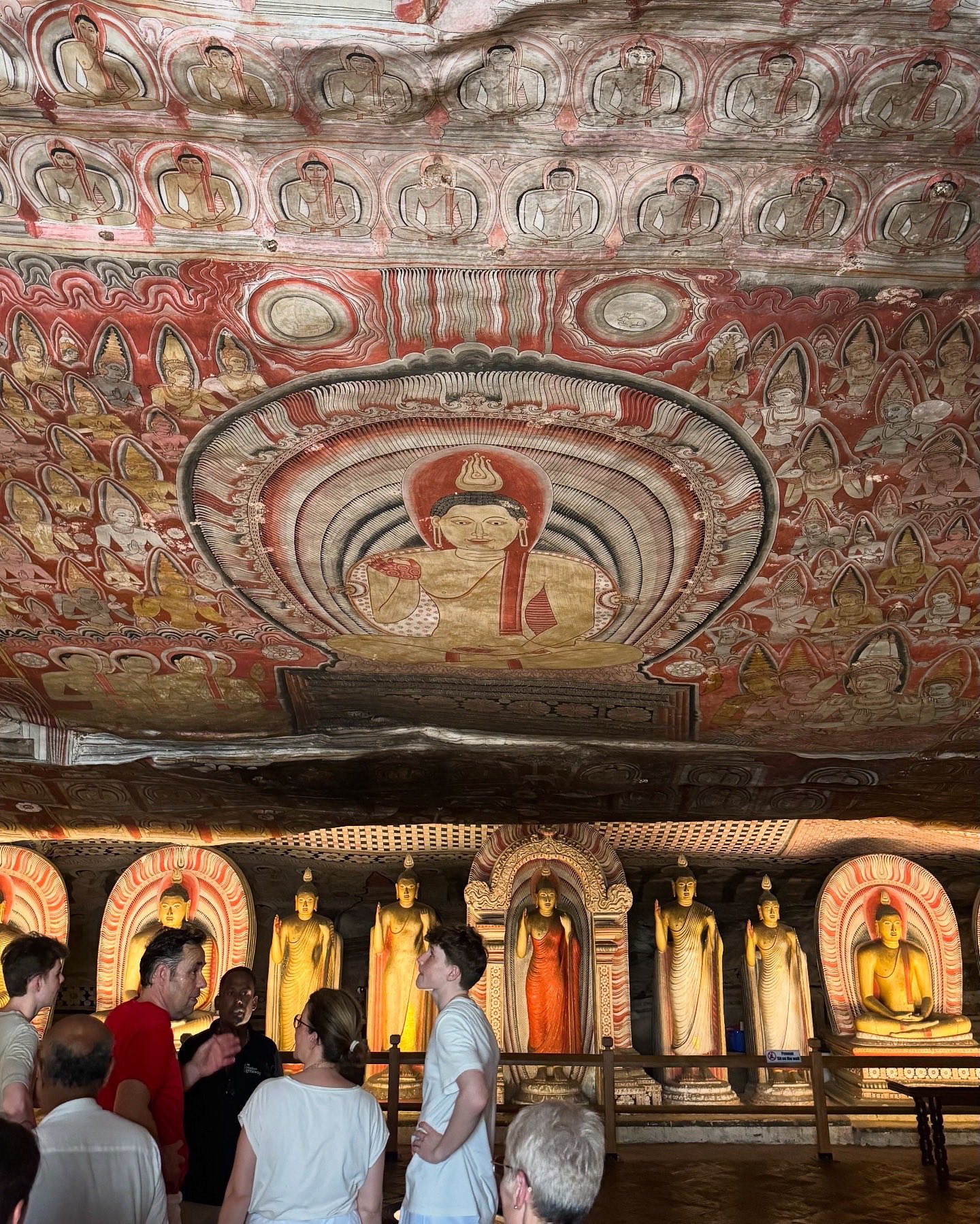Dambulla Rock Temple: Sri Lanka’s Most Impressive Cave Monastery
Templo de la Roca de Dambulla: El Monasterio de Cuevas más Impresionante de Sri Lanka
El Templo de la Roca de Dambulla, también conocido como el Templo Dorado de Dambulla, es uno de los sitios históricos y religiosos más impresionantes de Sri Lanka. Datado del siglo I a.C., este Patrimonio de la Humanidad de la UNESCO es el complejo de templos cueva más grande y mejor conservado del país. Enclavado bajo una roca de 150 metros de altura, el templo consta de cinco cuevas llenas de intrincadas pinturas, estatuas y reliquias religiosas. Una visita a Dambulla es imprescindible para los viajeros que exploran el Triángulo Cultural de Sri Lanka, que incluye Sigiriya, Anuradhapura, Polonnaruwa y Kandy.
Historia del Templo de la Roca de Dambulla

Este sitio sagrado ha sido un lugar de culto durante más de 2000 años. Según los registros históricos, el rey Valagamba (Vattagamini Abhaya) de Anuradhapura encontró refugio en estas cuevas después de ser exiliado de su reino por invasores del sur de la India. Una vez que recuperó su trono, transformó las cuevas en un magnífico monasterio budista, dedicándolo a la Sangha (monjes budistas). A lo largo de los siglos, el complejo del templo fue ampliado por varios gobernantes, incluidos los de los períodos de Polonnaruwa y Kandy, convirtiéndolo en un museo vivo del rico patrimonio budista de Sri Lanka.
Las Cinco Cuevas del Templo de la Roca de Dambulla
Cada una de las cinco cuevas del complejo del templo tiene una importancia histórica y artística única.
1. Devarajalena (Cueva del Rey Divino)
- La cueva más antigua del complejo.
- Presenta una estatua de Buda reclinado de 14 metros de largo, que ha sido repintada varias veces a lo largo de la historia.
- Contiene inscripciones Brahmi en la entrada, que marcan la fundación de la cueva.
2. Maharajalena (Cueva de los Grandes Reyes)
- La cueva más grande del complejo del templo.
- Alberga 16 estatuas de Buda de pie y 40 sentadas.
- Incluye estatuas de dioses hindúes, como Vishnu y Saman, a menudo adornadas con guirnaldas por los devotos.
- Contiene estatuas del rey Vatta Gamini Abhaya (Valagamba) y el rey Nissanka Malla, quienes contribuyeron a la expansión del templo.
3. Maha Aluth Viharaya (Gran Nuevo Monasterio)
- Construido durante el período de Kandy.
- Presenta estatuas de Buda y murales que representan escenas de la mitología budista.
- Incluye una estatua del rey Keerthi Sri Rajasinghe (1747-1781), un importante contribuyente a la restauración del templo.
4. Paccima Viharaya (Cueva Occidental)
- Una cueva más pequeña pero bien conservada con murales y estatuas budistas.
5. Devana Aluth Viharaya (Segundo Nuevo Templo)
- La adición más reciente al complejo.
- Contiene estatuas de Buda y pinturas intrincadas.
Maravillas Arquitectónicas y Artísticas

El Templo de la Cueva de Dambulla es conocido por su impresionante arquitectura excavada en la roca y sus detallados frescos, que cubren más de 2100 metros cuadrados de paredes y techos de cuevas. Estos murales representan:
- La vida de Buda y sus nacimientos anteriores (cuentos de Jataka).
- Eventos de la historia de Sri Lanka.
- Deidades hindúes como Vishnu y Saman, que muestran la influencia de la cultura hindú-budista.
El techo de roca está pintado en colores vibrantes, mezclándose perfectamente con los contornos naturales de la cueva, lo que lo convierte en una de las galerías de arte budista más impresionantes del mundo.
Mejor Época para Visitar
- De diciembre a abril (estación seca, ideal para hacer turismo).
- Temprano por la mañana (antes de las 9 AM) o tarde por la tarde (después de las 3 PM) para evitar multitudes y disfrutar de un clima más fresco.
Cómo Llegar al Templo de la Roca de Dambulla
Por Carretera
- Desde Colombo – 3.5 horas en coche (148 km) por la autopista A9.
- Desde Kandy – 2 horas en coche (72 km) por la autopista A9.
- Desde Sigiriya – 30 minutos en coche (17 km) por la carretera Inamaluwa-Sigiriya.
En Autobús
Hay autobuses a Dambulla disponibles desde Colombo, Kandy, Anuradhapura y Polonnaruwa. Desde la ciudad de Dambulla, puedes tomar un tuk-tuk hasta la entrada del templo.
Consejos de Viaje Esenciales
- Vístete con Modestia – Los hombros y las rodillas deben estar cubiertos ya que este es un sitio religioso.
- Quítate los Zapatos – El calzado debe quitarse antes de entrar a las cuevas.
- Lleva Agua – La subida puede ser agotadora, especialmente en clima cálido.
- Cuidado con los Monos – Los terrenos del templo albergan monos traviesos que podrían agarrar comida o pertenencias.
- Tarifa de Entrada – Aprox. 1500 LKR para extranjeros, gratis para ciudadanos de Sri Lanka.
¿Dónde Alojarse en Dambulla?
Estancias de Lujo
- Heritance Kandalama – Un impresionante hotel ecológico diseñado por Geoffrey Bawa.
- Jetwing Lake – Un resort de lujo con vistas impresionantes.
Estancias de Gama Media y Económicas
- Sigiriya Village Hotel – Una estancia confortable con fácil acceso a Sigiriya y Dambulla.
- Sundaras Resort & Spa – Un gran hotel de gama media con comodidades modernas.
Reflexiones Finales
El Templo de la Roca de Dambulla es un tesoro espiritual, histórico y artístico de Sri Lanka. Ya seas un entusiasta de la arquitectura, un amante de la historia o un peregrino budista, este antiguo monasterio cueva ofrece una experiencia inolvidable. Si estás explorando el Triángulo Cultural de Sri Lanka, no pierdas la oportunidad de visitar este increíble sitio de la UNESCO y presenciar sus impresionantes murales, estatuas y vistas panorámicas.
¿Planeando tu Viaje a Sri Lanka?
¡Suscríbete a srilankatourhelp.org para obtener las mejores guías de viaje, consejos y joyas ocultas en Sri Lanka!



Comentarios
No hay comentarios todavía